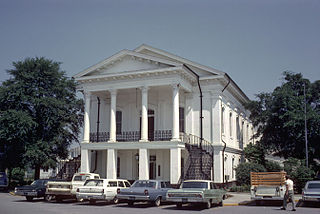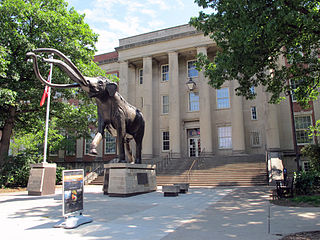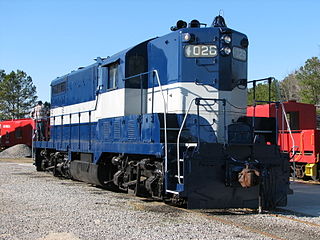
Barnwell is a city in and county seat of Barnwell County, South Carolina, United States, located along U.S. Route 278. The population was 4,750 at the 2010 census.

North Augusta is a city in Aiken and Edgefield counties in the U.S. state of South Carolina, on the north bank of the Savannah River. It lies directly across the river, and state border, from Augusta, Georgia. The population was 24,379 at the 2020 census, making it the 21st most populous city in South Carolina. The city is included in the Central Savannah River Area (CSRA) and is part of the Augusta, Georgia, metropolitan area.

Augusta is a consolidated city-county on the central eastern border of the U.S. state of Georgia. The city lies directly across the Savannah River from North Augusta, South Carolina at the head of its navigable portion. Georgia's third most populous city, Augusta is located in the Fall Line section of the state.

The Buffalo Museum of Science is a science museum located at Martin Luther King Jr. Park in Buffalo, New York, United States, northeast of the downtown district, near the Kensington Expressway. The historic building was designed by August Esenwein and James A. Johnson and opened on January 19, 1929. It gave a permanent home to the exhibits that started to be collected by the Buffalo Young Men's Association, which had passed them to its 1861 creation, the Buffalo Natural History Society, with George W. Clinton chosen as the Society's first president.

The National Museum of American History: Kenneth E. Behring Center is a historical museum in Washington, D.C. It collects, preserves, and displays the heritage of the United States in the areas of social, political, cultural, scientific, and military history. Among the items on display is the original Star-Spangled Banner. The museum is part of the Smithsonian Institution and located on the National Mall at 14th Street and Constitution Avenue NW in Washington, D.C.

The University of Nebraska State Museum, also known as Morrill Hall, founded in 1871, is a natural history museum featuring Nebraska biodiversity, paleontology, and cultural diversity, located on the University of Nebraska–Lincoln City Campus near the corner of 14th and Vine Streets in Lincoln, Nebraska, United States. The museum houses Mueller Planetarium, a hands-on science discovery center, and the Elephant Hall, where visitors can see the world's largest articulated fossil mammoth among the collection of fossil elephants. Also featured are interactive paleontology exhibits, a dinosaur gallery, ancient life and evolution exhibits, wildlife dioramas, gems and minerals, American Indian and African exhibits, and a temporary exhibit gallery featuring rotating displays on diverse topics including photography, quilts and fine arts.

CSS Georgia, also known as State of Georgia and Ladies' Ram, was an ironclad warship built in Savannah, Georgia in 1862 during the American Civil War. The Ladies' Gunboat Association raised $115,000 for her construction to defend the port city of Savannah.

The Buffalo Bill Center of the West, formerly known as the Buffalo Bill Historical Center, is a complex of five museums and a research library featuring art and artifacts of the American West located in Cody, Wyoming. The five museums include the Buffalo Bill Museum, the Plains Indians Museum, the Whitney Western Art Museum, the Draper Natural History Museum, and the Cody Firearms Museum. Founded in 1917 to preserve the legacy and vision of Col. William F. "Buffalo Bill" Cody, the Buffalo Bill Center of the West is the oldest and most comprehensive museum complex of the West.

The World of Coca-Cola is a museum located in Atlanta, Georgia, United States, showcasing the history of The Coca-Cola Company. The 20-acre (81,000 m2) complex opened to the public on May 24, 2007, relocating from and replacing the original exhibit, which was founded in 1990 in Underground Atlanta. There are various similar World of Coca-Cola stores in locations such as Las Vegas and Disney Springs.
Atlanta History Center is a history museum and research center located in the Buckhead district of Atlanta, Georgia. The Museum was founded in 1926 and currently consists of nine permanent, and several temporary, exhibitions. Atlanta History Center's campus is 33-acres and features historic gardens and houses located on the grounds, including Swan House, Smith Farm, and Wood Family Cabin. Atlanta History Center's Midtown Campus includes the Margaret Mitchell House & Museum. The History Center's research arm, Kenan Research Center, is open by appointment, and provides access to the archival collections. Atlanta History Center holds one of the largest collections of Civil War artifacts in the United States.

The Georgia Railroad and Banking Company also seen as "GARR", was a historic railroad and banking company that operated in the U.S. state of Georgia. In 1967 it reported 833 million revenue-ton-miles of freight and 3 million passenger-miles; at the end of the year it operated 331 miles (533 km) of road and 510 miles (820 km) of track.

The Central of Georgia Railway started as the Central Rail Road and Canal Company in 1833. As a way to better attract investment capital, the railroad changed its name to Central Rail Road and Banking Company of Georgia. This railroad was constructed to join the Macon and Western Railroad at Macon, Georgia, in the United States, and run to Savannah. This created a rail link from Chattanooga, on the Tennessee River, to seaports on the Atlantic Ocean. It took from 1837 to 1843 to build the railroad from Savannah to the eastern bank of the Ocmulgee River at Macon; a bridge into the city was not built until 1851.

The Royal Alberta Museum (RAM) is a museum of human and natural history in Downtown Edmonton, Alberta, Canada, located north of City Hall. The museum is the largest in western Canada with more than 7,600 square metres (82,000 sq ft) exhibition space and 38,900 square metres (419,000 sq ft) in total.
The Charleston and Western Carolina Railway (C&WC) was formed in 1896 to operate the lines of the former Port Royal and Augusta Railway (PR&A) and the Port Royal and Western Carolina Railway (PR&WC). The PR&A and PR&WC had originally been part of the Central of Georgia Railroad but the South Carolina Legislature had forced the railroad to give up the subsidiary lines. The Atlantic Coast Line Railroad (ACL) took over the C&WC in 1897 but operated it as a subsidiary until 1959 when the ACL fully absorbed it. Much of the original system is still in use by ACL successor CSX Transportation.
The Museum of Life and Science—previously known as the North Carolina Museum of Life and Science and the NC Children's Museum—is an 84-acre (340,000 m2) science museum located in Durham, North Carolina, United States.
William Washington Gordon was an American politician and businessman.

The Rochester Museum & Science Center (RMSC) is a museum in Rochester, New York, dedicated to community education in science, technology and local history. The museum also operates the Strasenburgh Planetarium, located next to the museum, and the Cumming Nature Center, a 900-acre (3.6 km2) nature preserve near Naples, New York. The museum resides at 657 East Ave. and has a collection of 1.2 million artifacts.

Augusta, Georgia was founded in 1736 as part of the British colony of Georgia, under the supervision of colony founder James Oglethorpe. It was the colony's second established town, after Savannah. Today, Augusta is the second-largest city in Georgia, and the largest city of the Central Savannah River Area.

The culture of Augusta, Georgia is influenced by the many different perspectives and histories of its community members, as well as its own history. The large military population of the area as well as the city's rural surroundings have affected the types of festivals and culture produced within the city. Another major influence on the culture of the city is the annual Masters golf tournament held in April of each year. The most prolific cultural medium produced by the city is its musicians, as evidenced by James Brown, Jessye Norman, and Wycliffe Gordon. Though notably, the writer Frank Yerby and visual artist Jasper Johns were Augusta natives as well.

The Runestone Museum is a historical museum located in Alexandria, Minnesota, United States. Established in 1958, the museum is renowned for housing the Kensington Runestone, a controversial artifact considered by some to be evidence of pre-Columbian Viking exploration of North America.
















